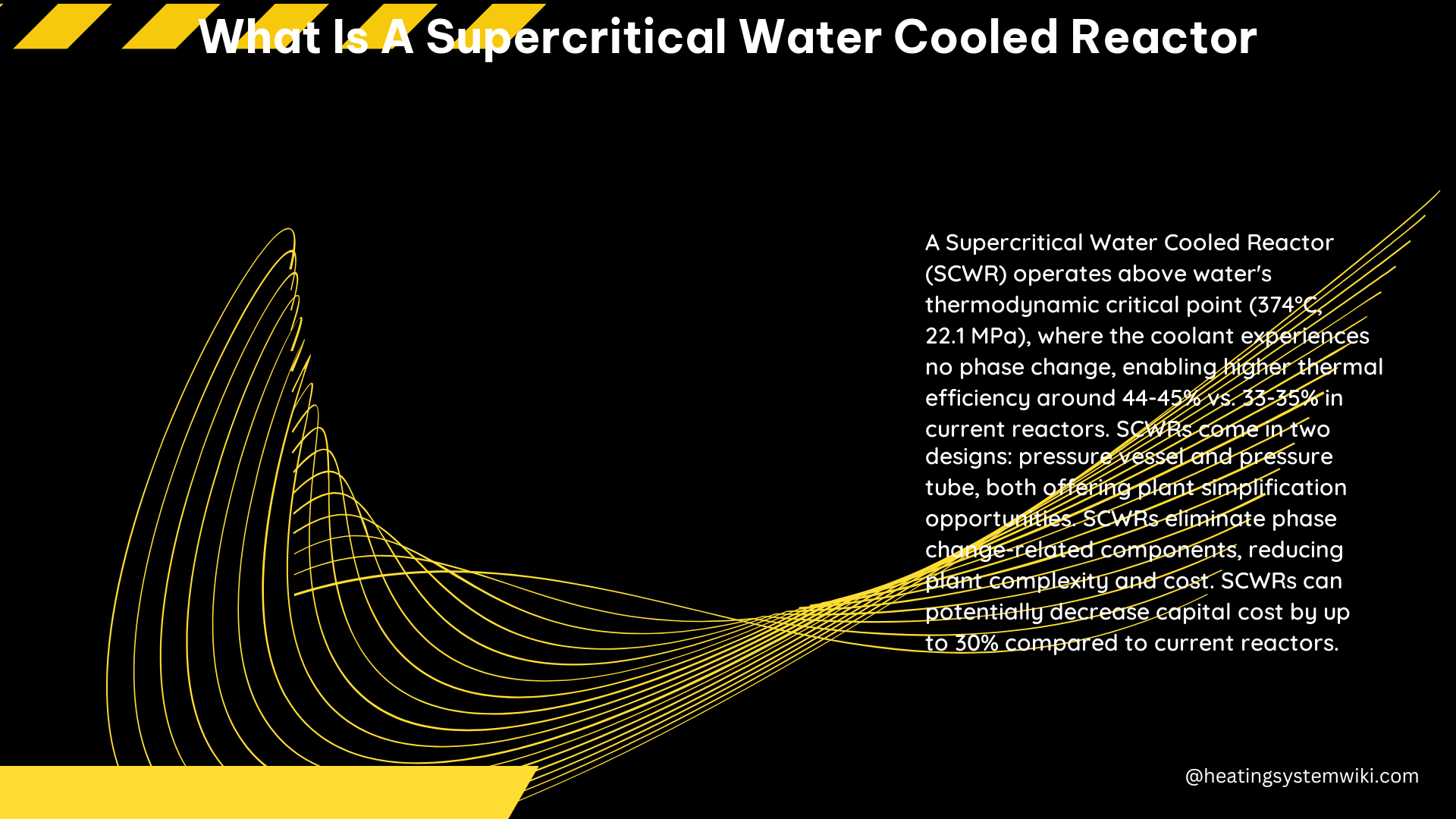A Supercritical Water Cooled Reactor (SCWR) is a Generation IV reactor concept designed as a light water reactor (LWR) that operates at supercritical pressure, typically greater than 22.1 megapascals (3,210 psi). The term “critical” in this context refers to the critical point of water, not the criticality of the nuclear reactor.
Understanding the Supercritical Water Cooled Reactor
In an SCWR, the water heated in the reactor core becomes a supercritical fluid above the critical temperature of 374°C (705°F) and critical pressure of 22.064 MPa (3,208 psi). At this point, the water transitions from a fluid more resembling liquid water to a fluid more resembling saturated steam, without going through the distinct phase transition of boiling.
This unique property of supercritical water allows for the direct use of the heated water in a steam turbine, eliminating the need for a secondary cooling loop and associated components such as:
- Steam generators
- Steam dryers
- Steam separators
found in traditional pressurized water reactors (PWR) and boiling water reactors (BWR).
Advantages of Supercritical Water Cooled Reactors

The main advantages of SCWRs are:
- Improved Economics:
- Thermal efficiency of SCWRs is expected to be 1.2 to 1.4 times higher than current water-cooled reactors.
-
This is due to the high temperature (up to 625°C) and high pressure (up to 25 MPa) of the turbine inlet steam.
-
Plant Simplification:
- Elimination of recirculation systems, steam-water separation systems, and steam generators.
- Reduced number of primary system components, leading to lower capital costs.
-
Incorporation of supercritical turbines from fossil power plants, which further increases thermal efficiency and simplifies the plant system.
-
Safety Improvements:
- SCWR operates above the critical pressure of water, where the coolant experiences no phase change.
- Coolant temperature can exceed the pseudo-critical temperature (corresponding to the boiling temperature at subcritical pressure) without the abrupt degradation in heat transfer at fuel rod surfaces covered by steam, a common issue in current water-cooled reactors.
SCWR Design Options
Two main design options are considered for the SCWR:
- Pressure Vessel Design:
- Similar to a conventional PWR, with the reactor core and primary coolant system contained within a single pressure vessel.
-
Advantages include simpler design and easier maintenance.
-
Pressure Tube Design:
- Reactor core is divided into individual pressure tubes, similar to a CANDU reactor.
- Advantages include easier refueling and potential for higher power density.
Both design options share common R&D needs, such as:
- Thermal-hydraulics
- Materials
- Water chemistry
- Other technical feasibility assessments
This provides valuable collaboration opportunities for countries and organizations pursuing either option.
DIY Perspective on Supercritical Water Cooled Reactors
For a DIY perspective, understanding the principles of SCWRs can be approached by studying the design and operation of supercritical fossil power plants, which have been operating successfully for more than 40 years.
The main fossil power plant technology used in the SCWR is supercritical turbines, which can be incorporated in a direct thermodynamic cycle to increase thermal efficiency. Developing the balance of power (BOP) of the SCWR would involve limited or almost no R&D, as the use of a direct cycle at supercritical conditions simplifies the plant system and eliminates certain components, reducing capital cost.
Conclusion
Supercritical Water Cooled Reactors (SCWRs) are a promising Generation IV reactor concept that offer improved economics, plant simplification, and enhanced safety features compared to traditional water-cooled reactors. By understanding the principles of supercritical water and the design options available, DIY enthusiasts can gain valuable insights into the development of this advanced nuclear technology.
References:
- Supercritical Water-Cooled Reactor (SCWR) Development through GIF Collaboration, T. Schulenberga, L.K.H. Leungb, D. Bradyc, Y. Okad, K. Yamadae, Y. Baef and G. Willermozg, accessed on June 12, 2024, https://www-pub.iaea.org/MTCD/publications/PDF/P1500_CD_Web/htm/pdf/topic5/5S06_H.%20Khartabil.pdf
- Super Critical Water-Cooled Nuclear Reactors (SCWRs) Thermodynamic Cycle Options and Thermal Aspects of Pressure-Channel Design, M. Naidin, I. Pioro, R. Duffey*, S. Mokry, L. Grande, B. Villamere, L. Allison, A. Rodriguez-Prado, S. Mikhael and K. Chophla, accessed on June 12, 2024, https://www-pub.iaea.org/MTCD/publications/PDF/P1500_CD_Web/htm/pdf/topic5/5S03_I.%20Pioro.pdf
- Supercritical Water Reactor, Wikipedia, accessed on June 12, 2024, https://en.wikipedia.org/wiki/Supercritical_water_reactor
